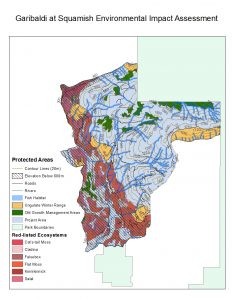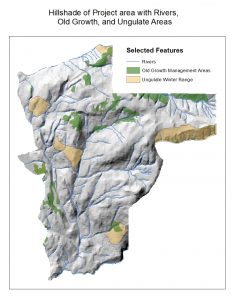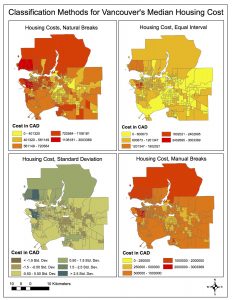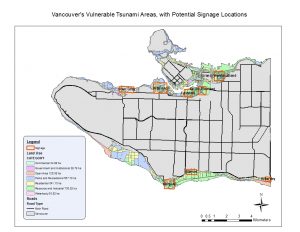

As a natural resource planner, there are a number of issues regarding the proposed ski resort that must be addressed in order to successfully continue with the project. My goal is to provide information as to which issues are of particular importance to ensure the project does not negatively impact both the project area and the surrounding park.
In order to better understand the issues, I have created a map from data acquired from DataBC regarding ungulate inhabitance in the area, old growth forest areas, fish habitat, and rivers. I have overlaid these areas on a map of the project area in order to highlight areas that contain animal and forest area at risk, with the areas of overlap representing critical habitat.
With 31.79% of the project area being below 600 meters in elevation, we see this area as being ruled out. However, sensitive areas that occur below 600 meters largely exted to about 800 meters. At this elevation, we see many red-listed ecosystems, resulting in project unfeasibility below this elevation. Above 800 meters, we see some old grown areas and winter ungulate inhabitance, but the project becomes much more feasible above 800 meters. Overall, the percentage of the project area that would directly impact areas of concern is as follows:
Old growth forest – 6.78%
Ungulate areas – 7.89%
Red-listed species area – 24.83%
Fish areas – 15.85
We see the concentration of fish habitat and red-listed species impact occurring below 800 meters in elevation. Thus, the two major concerns above that elevation (and where most ski resort development would occur) are that of old growth management areas and ungulate areas.
In order to mitigate damage to these areas, I suggest building lifts and other developments to the south-east of the project area. As rivers largely become iced-over in the wintertime, the rivers in this area are of lesser concern. Additionally, I encourage you to build ski lifts between areas of old growth management. This will ensure that the resort can meet skier demand and offer great old-growth skiing, while at the same time preserving these ecosystems.
I also advise you to avoid building parking infrastructure, lodging, and major lift/gondola developments in the areas of red-listed ecosystems. There is the potential for a gondola to fragment these ecosystems, but if built correctly, these effects can be mitigated.


